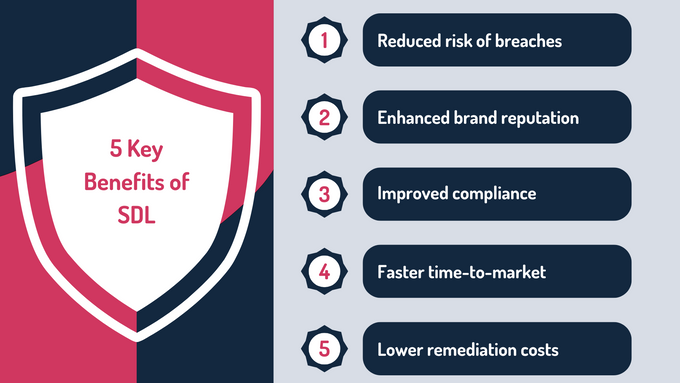Agile SDLC: Streamlining Secure Development for Faster Delivery
Discover how the secure development lifecycle (SDL) fits into Agile workflows to strengthen security while maintaining development speed. Proactive practices like risk assessments, secure coding, and penetration testing help reduce vulnerabilities, achieve compliance, and protect against threats.
Published April 5, 2025.

With businesses facing a cyberattack every 39 seconds, the need for secure software development has never been more important. The Secure Development Lifecycle (SDL) embeds security into every phase of the software development lifecycle (SDLC) workflow, safeguarding applications against vulnerabilities and minimizing risks.
In fast-paced SDLC and Agile environments, SDL ensures the perfect balance between speed, security, and compliance—critical for protecting sensitive data and maintaining customer trust.
» Secure your Agile workflows with GRSee
Traditional vs. Agile Software Development Models
The traditional SDLC follows a sequential, rigid process with distinct phases such as:
- Requirements gathering
- Design
- Implementation
- Testing
- Deployment
- Maintenance
This approach, often called the Waterfall model, is best suited for projects with clearly defined requirements and minimal scope for changes. However, it can be less adaptable to evolving needs and often results in delayed feedback on security or functionality issues.
In contrast, the Agile SDLC model embraces flexibility, iterative development, and continuous feedback. Agile integrates security and development practices into shorter, incremental cycles, such as sprints. This allows teams to adapt to changing requirements and address security concerns early, ensuring faster delivery without sacrificing quality.
| Category | Traditional SDLC | Agile SDLC |
|---|---|---|
| Process Structure | Sequential, phase-based | Iterative, cycle-based (e.g., sprints) |
| Flexibility | Rigid & difficult to adapt to changes | Highly flexible & adapts to evolving requirements |
| Feedback | Limited, received at the end of the development | Continuous feedback throughout development |
| Security Integration | Typically addressed in later stages | Embedded throughout all stages |
| Time-to-Market | Longer due to sequential phases | Faster due to iterative delivery |
| Best Use Cases | Stable, well-defined projects | Dynamic, fast-evolving projects |
» Boost your organization's security with the CIA triad
Is SDL Worth It? Exploring ROI and Key Benefits
Yes, SDL significantly enhances ROI through long-term savings and operational efficiency. While it may seem costly initially, addressing security early in the design phase reduces expensive late-stage fixes. Proactively identifying vulnerabilities streamlines development, ensuring cost-effectiveness and high-quality results.
1. Reduced Risk of Breaches
Proactive security measures integrated throughout the development lifecycle help identify and mitigate vulnerabilities early, significantly lowering the likelihood of successful cyberattacks and protecting sensitive data. Integrating pentesting into Agile development ensures that these vulnerabilities are identified continuously, even during rapid iterations.
2. Enhanced Brand Reputation
A strong security posture fosters trust among customers and partners, positioning your organization as a reliable and responsible entity. Secure applications reflect a commitment to safeguarding user data and strengthening long-term relationships.
3. Improved Compliance
With an Agile SDLC methodology, adherence to industry regulations and standards such as PCI DSS, GDPR, and ISO 27001 becomes much more streamlined. This reduces the risk of non-compliance penalties and ensures readiness for audits.
» Compare traditional compliance methods to automation
4. Faster Time-to-Market
Early identification and resolution of security risks prevent delays caused by late-stage fixes. SDL optimizes development workflows, enabling teams to deliver secure software faster without compromising quality.
5. Lower Remediation Costs
Fixing security issues early in the development cycle is significantly less expensive than addressing vulnerabilities post-deployment. SDL ensures an efficient process that minimizes costly disruptions and resource use later on.
Phases of SDLC in Agile Development: Embedding Security
The 6 Phases of the SDLC
1. Planning
The planning phase involves defining the project's scope, objectives, and resource allocation. Stakeholders outline the business requirements and identify potential risks or constraints. This phase sets the foundation for successful development.
2. Requirements Analysis
During this phase, the team gathers detailed functional and non-functional requirements. Analysts work closely with stakeholders to ensure the software aligns with business goals while addressing user needs.
Additionally, security requirements such as encryption or compliance standards are also defined.
3. Design
The design phase focuses on creating architectural plans and detailed blueprints for the software. Teams produce diagrams, data flow structures, and user interfaces. Security measures (such as access controls or secure coding principles) are integrated into the design.
4. Development
This phase involves writing the code based on the design documents. Developers use secure coding practices to ensure the application is resilient to vulnerabilities. Continuous integration and version control are often applied for efficiency and quality control.
5. Testing
In the testing phase, the software undergoes rigorous quality assurance. Testing includes functional, performance, and security evaluations, such as static and dynamic analysis. Any identified issues are resolved before moving forward to deployment.
6. Deployment and Maintenance
Once testing is complete, the software is deployed to production. DevOps teams oversee this phase to ensure smooth transitions. Post-deployment maintenance (including monitoring and updates) ensures the software remains secure, reliable, and up-to-date with evolving user requirements.
SDL begins with embedding security requirements into the client’s needs during the initial planning phase. First, risk assessment and threat modeling address Agile software development security concerns, ensuring alignment with both SDLC and Agile practices.
» Here's what you should know before hiring a risk assessment provider
Before moving to production, Agile penetration testing validates the application's resilience, ensuring that all threats are addressed. Once vulnerabilities are resolved, a separate team deploys the application, and ongoing monitoring ensures its security in production environments.
This iterative and integrated approach aligns perfectly with Agile methodologies, addressing evolving security concerns without slowing down development.
Integrating SDL Into Agile Methodologies
Successfully merging the SDL into Agile methodologies, such as Scrum and Kanban, enables teams to address security concerns without disrupting the fast-paced nature of Agile workflows. This integration ensures that security becomes an intrinsic part of the development process, aligning with Agile principles of adaptability and collaboration.
Here’s how security can be embedded into specific Agile practices:
Scrum: Building Security Into Sprints
- Sprint planning: Security begins during sprint planning. Teams should prioritize security-related user stories in the product backlog and set sprint goals that include addressing vulnerabilities, performing threat assessments, or implementing secure coding practices.
- Daily stand-ups: Daily stand-ups offer an excellent opportunity to discuss security tasks, risks, and blockers. For example, developers can highlight any challenges they face in meeting secure coding standards or executing security tests. Early identification of issues allows the team to resolve them before they impact progress.
- Sprint review: During the sprint review, teams should assess not only functional deliverables but also the security measures implemented. Demonstrating how security tasks were completed, such as conducting code reviews or vulnerability scans, reinforces accountability and keeps stakeholders informed.
- Sprint retrospective: The retrospective provides a chance to reflect on the security practices used during the sprint. Teams can identify what worked well, such as the successful execution of penetration tests, and highlight areas for improvement—such as refining threat modeling or incorporating additional security tools in future sprints.
» Learn how penetration testing can take you beyond compliance
Kanban: Continuous Flow With Built-In Security
- Security Kanban board: A Kanban board dedicated to security tasks helps visualize progress and ensures transparency. Columns can represent stages like "To Do," "In Progress," and "Completed," while cards can detail tasks such as code reviews, Agile penetration testing, or implementing encryption. This visual approach aligns security tasks with the overall development flow.
- Security checklists: Checklists simplify the tracking of essential security activities. For example, teams can create lists for secure code reviews, vulnerability scans, or compliance audits. As tasks move through the workflow, checklists ensure nothing critical is overlooked.
- Security gates: Security gates act as checkpoints within the Kanban workflow to ensure that security requirements are met before tasks advance. For instance, before moving a feature to production, it must pass a final security gate where all necessary tests and reviews are validated.
Key Security Controls for SDL QA
1. Security Requirements and Design
- Compile a list of security and privacy requirements alongside business needs during the planning phase
- Include input from the CISO and legal obligations, such as encryption and two-factor authentication (2FA)
- Ensure security considerations are built into the high-level design (HLD) from the start
» Did you know? You can cut the budget of maintaining a full-time CISO with a virtual CISO
2. Risk Assessment & Threat Modeling
- Conduct assessments post-HLD to identify and document risks and security gaps
- Map countermeasures for mitigation to ensure early threat detection and resolution
» Make sure you know what's involved in the risk assessment process
3. Secure Coding
- Train developers in secure coding practices to align code with organizational security goals
- Reinforce skills through workshops, training programs, or online solutions to minimize coding vulnerabilities
Logical errors and nuanced security risks may go unnoticed in automated processes, making this step crucial. Assign independent reviewers to assess the code for weaknesses, ensuring a robust final product.
4. QA & Security Testing
- Use automated testing tools to identify errors quickly before manual reviews
- Conduct manual reviews for a thorough evaluation of the code's strength and integrity
- Use Static Application Security Testing (SAST) to identify code-level security issues
- Conduct Dynamic Application Security Testing (DAST) on staging servers to simulate real-world attack scenarios
Incorporating automated testing into your Agile SDL ensures efficiency without adding significant overhead. Techniques such as SAST process workflows, dependencies weak version detection, and DAST require minimal manual intervention when properly implemented. These processes deliver exceptional value by identifying vulnerabilities early and reducing costs over time.
After automated tests, a manual code review is indispensable. Logical errors and nuanced security risks may go unnoticed in automated processes, making this step crucial. Assign independent reviewers to assess the code for weaknesses, ensuring a robust final product.
» Discover the future of cybersecurity with AI
5. Penetration Testing (PT)
- Perform penetration tests to simulate cyberattacks and identify exploitable vulnerabilities
- Use findings to bolster application resilience before production release
Conducting Agile penetration testing annually or after significant changes is a strategic approach to fortifying your cybersecurity and balancing security with Agile workflows. For organizations with low risk tolerance, small-scale tests targeting specific application changes can be performed throughout the year. Developers must address any vulnerabilities promptly to maintain a secure development lifecycle.
» Not sure where to begin? Start by understanding the different types of penetration tests
7. Uploading to Production
- Assign production uploads to dev-ops or IT teams to prevent unnecessary access by developers
- Minimize security risks by maintaining separation of duties
Uploading code to production is inevitable but must be done securely. To minimize risks, restrict the upload process to a separate operations team, ensuring no single group has excessive access or control over the system.
8. Ongoing Monitoring
- Continuously monitor live applications to detect and prevent attacks in real-time
- Implement anomaly detection and alert systems to ensure rapid response to threats
Despite the best security measures, attacks are always a possibility. Real-time monitoring plays a pivotal role in identifying and mitigating threats before they escalate. Robust monitoring systems with anomaly detection, log analysis, and alert mechanisms ensure quick response to potential breaches.
Maintain Agile SDLC Practices With GRSee
In today's fast-paced digital landscape, Agile methodologies have revolutionized software development, enabling faster delivery and increased responsiveness to market demands. However, prioritizing speed can sometimes overshadow security considerations. By integrating security principles throughout the entire Agile SDLC, organizations can mitigate risks, improve software quality, and ultimately deliver more secure and reliable products to their customers.
GRSee offers a range of cyberservice solutions, from security assessments and penetration testing to expert consulting and training, to help organizations seamlessly integrate security into their Agile workflows. By partnering with GRSee, you can leverage our expertise to build a robust security posture and ensure that your software is efficient and secure, meeting the evolving demands of the modern digital world.
» Ready for help? Contact GRSee to learn how we can secure development for your Agile workflows





